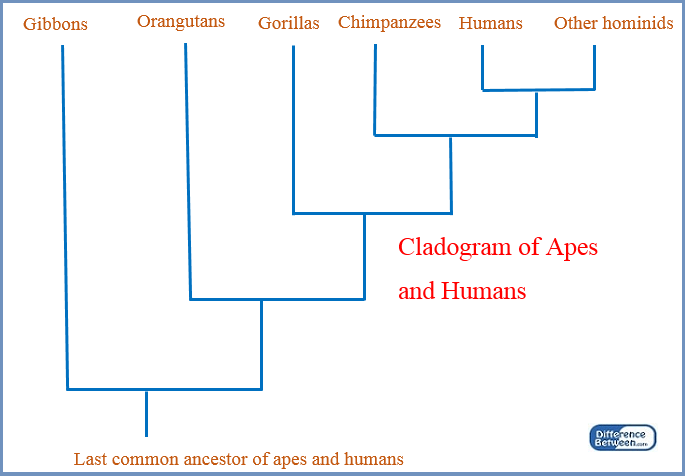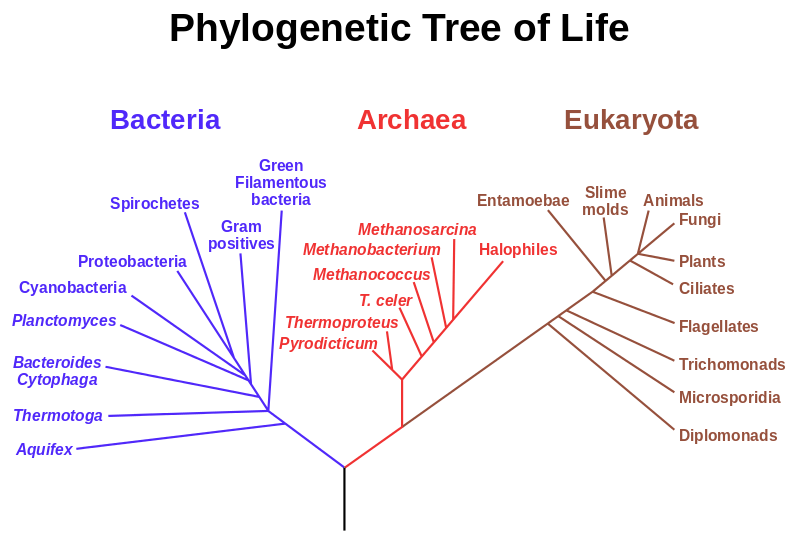Difference Between Cladogram and Phylogenetic Tree
Table of Contents
Key Difference – Cladogram vs Phylogenetic Tree
Evolution and phylogeny are closely related two words which help to describe relationships and characteristics of different organisms. Evolution explains how a particular group of organism has been evolved, developed and selected through the timeline. Phylogeny explains the historical development of an organism. There are different diagrams constructed by the biologists to show the relationships between organisms. Phylogenetic tree and cladogram are two such diagrams developed to show the relatedness between different organisms. The key difference between cladogram and phylogenetic tree is that cladogram shows only the relationship between different organisms with respective to a common ancestor while phylogenetic tree shows the relationship between different organisms with respect to the evolutionary time and the amount of change with time.
CONTENTS
1. Overview and Key Difference
2. What is a Cladogram
3. What is a Phylogenetic Tree
4. Side by Side Comparison – Cladogram vs Phylogenetic Tree
5. Summary
What is a Cladogram?
A cladogran is a diagrammatic representation which shows the relationship of the closely related organisms. It is a type of a phylogenetic tree. But it only shows the relationships between clades with the common ancestor. As an example, a cladogram shows human are more loosely related with chimpanzees than gorilla, but it does not show the evolutionary time and the exact distance from the common ancestor.
Cladogram is a tree-like diagram which is drawn using lines. The nodes of a cladogram represent the splitting of two groups from a common ancestor. Clades are summarized at the ends of the lines and the members of a particular clade share similar characteristics. Clades are built using molecular differences instead of morphological characteristics. However, cladograms can be constructed using the correct morphological and behavioral data as well.

Figure 01: A Primate Cladogram
What is a Phylogenetic Tree?
Phylogenetic studies are useful for finding answers to different problems in evolutionary biology such as the relationship between species and their origin, spread of viral infections, migration patterns of species, etc. Advanced molecular biological techniques have helped biologists to evaluate phylogenetic relationships between organisms in relation to the evolutionary changes of the organisms. A phylogenetic tree is a diagram which shows the relationship between organisms based on their characteristics, genetic background, and evolutionary relationships. Compared to a cladogram, phylogenetic tree has more value when discussing the relationships of organisms in a meaningful way with respect to their ancestors and evolution. Phylogenetic tree is drawn like a branching tree diagram in which branch length is proportional to the evolutionary distance, unlike a cladogram.
Biologists analyze different characteristics of organisms using different analytical tools such as parsimony, distance, likelihood and bayesian methods, etc. They consider many characteristics of organisms including morphological, anatomical, behavioral, biochemical, molecular and fossil characteristics to construct phylogenetic trees.

Figure 02: A phylogenetic tree
What is the difference between Cladogram and Phylogenetic Tree?
Cladogram vs Phylogenetic Tree | |
| Cladogram is not an evolutionary tree. Therefore, it doesn’t show evolutionary relationships. | Phylogenetic tree is an evolutionary tree. It shows evolutionary relationships. |
| Usage | |
| Cladogram represents a hypothesis about the actual evolutionary history of a group. | Phylogenetic tree represents the true evolutionary history of organisms. |
| Length of the Branches | |
| Cladogram is drawn with equal-length. The length of the branch does not represent an evolutionary distance. | Branch length of a phylogenetic tree indicates the evolutionary distance. |
| Indication of the Evolutionary Time | |
| Cladogram does not indicate the amount of evolutionary time when separating the organisms’ taxa. | Phylogenetic tree indicates the amount of evolutionary time when separating the organisms’ taxa. |
Summary – Cladogram vs Phylogenetic Tree
A cladogram is a diagram which shows the relationship between different organisms based on their different similarities. A phylogenetic tree is a diagram which shows the phylogenetic history of organisms with respect to the geological time scale. It represents possible relationships among organisms and the evolutionary history. This is the difference between a cladogram and a phylogenetic tree.
References:
1. Woese, Carl R. “Interpreting the universal phylogenetic tree.” Proceedings of the National Academy of Sciences of the United States of America. The National Academy of Sciences, 18 July 2000. Web. 03 Apr. 2017
2. Hall, Barry G. “Building Phylogenetic Trees from Molecular Data with MEGA.” Molecular Biology and Evolution. Oxford University Press, 12 Mar. 2013. Web. 03 Apr. 2017
Image Courtesy:
1. “Phylogenetic tree” By This vector version: Eric Gaba (Sting – fr:Sting) – NASA Astrobiology Institute, found in an article (Public Domain) via Commons Wikimedia
ncG1vNJzZmivp6x7pbXFn5yrnZ6YsqOx07CcnqZemLyue8OinZ%2Bdopq7pLGMm5ytr5Wau26vy5qbqJ%2Bilrpurc2dZK%2BrXaW1urjOoJynnaSesG7A0Z6caA%3D%3D